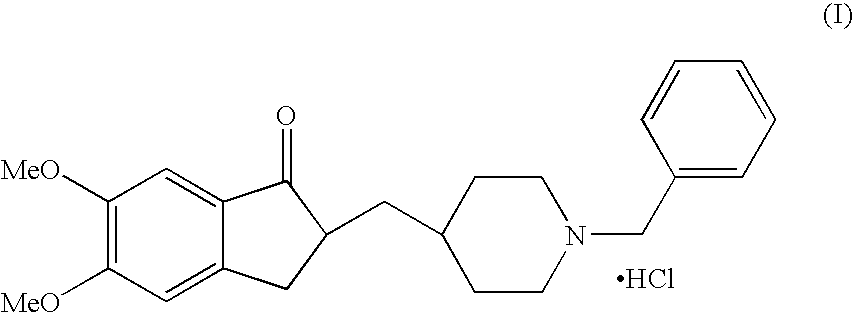Process And Intermediate For Preparation Of Donepezil
a technology of donepezil and intermediates, which is applied in the field of process for the synthesis of acetylcholinesterase inhibitors, can solve the problems of high cost of reaction and requires cryogenic conditions for reaction to take pla
- Summary
- Abstract
- Description
- Claims
- Application Information
AI Technical Summary
Problems solved by technology
Method used
Image
Examples
example 1
Preparation of N-1-Benzyl-4(2′-ethyl carboxylate)epoxy Piperidine
[0025]To a 500 ml flask fitted with a nitrogen inlet and CaCl2 guard tube, 300 ml of dry toluene was added. To this, was added a mixture of 100 g (0.529 mol) N-benzyl 4-piperidone and 65.0 g (0.53 mol) ethyl chloroacetate. The contents were chilled to −5 C and sodium amide 31.0 g (0.793 mol) was added in lots over a period of 2 h with the temperature maintained between below 0° C. Once the addition was over, the contents were warmed to room temperature (about 25° C.) and stirred for 2 h. The reaction mass was slowly poured into a beaker filled with crushed ice and extracted into 500 ml ethyl acetate. The organic layer was washed with 3 portions of 400 ml water with the last portion containing 6 ml acetic acid. The organic layer was dried over anhydrous sodium sulphate and men concentrated under vacuum to yield 102.0 g of the crude glycidic ester (70% yield), which was used as such for further step without any purificat...
example 2
Preparation of N-1-Benzyl-4(2′-sodium carboxylate)epoxy piperidine-5-carboxylic Acid
[0026]The glycidic ester from Example 1 was slowly poured into a 15° C. solution of sodium methoxide in ethanol and then warmed to room temperature (22° C.) and stirred overnight to obtain a solid. The solid was filtered off under vacuum and washed with 50 ml ethanol, followed by 50 ml diethyl ether. The off-white solid weighed 88.0 g (85%).
example 3
Preparation of N-benzyl 4-formyl Piperidine
[0027]The sodium salt from example 2 was dissolved in 250 ml water containing 50 ml HCl and heated reflux temperature (at about 90° G) and maintained for 2 hours. The reaction mass was then cooled to 15° C. with the aid of ice-water and liquor ammonia slowly added to the solution to render the pH alkaline. The contents were extracted into 300 ml dichloro methane, washed with water and dried over anhydrous sodium sulphate. The organic layer was concentrated under vacuum to yield yellow coloured oil. 45 g (68% yield).
PUM
 Login to View More
Login to View More Abstract
Description
Claims
Application Information
 Login to View More
Login to View More - R&D
- Intellectual Property
- Life Sciences
- Materials
- Tech Scout
- Unparalleled Data Quality
- Higher Quality Content
- 60% Fewer Hallucinations
Browse by: Latest US Patents, China's latest patents, Technical Efficacy Thesaurus, Application Domain, Technology Topic, Popular Technical Reports.
© 2025 PatSnap. All rights reserved.Legal|Privacy policy|Modern Slavery Act Transparency Statement|Sitemap|About US| Contact US: help@patsnap.com



